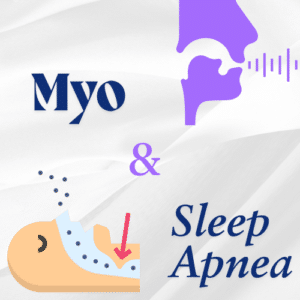Myofunctional Therapy for Sleep Apnea

Table of Contents
Introduction
Obstructive sleep apnea (OSA) is a multifaceted condition that affects millions worldwide. Successful management requires a multidisciplinary approach. One emerging and evidence-based adjunct is orofacial myofunctional therapy (OMT)—a targeted approach to improve orofacial muscle function, optimize airway dynamics, and complement conventional treatments like CPAP or oral appliances.
Understanding Obstructive Sleep Apnea and Its Challenges
OSA is characterized by repeated upper airway collapse during sleep, leading to intermittent hypoxia, fragmented sleep, and systemic health complications such as cardiovascular disease, diabetes, and cognitive impairments. Contributing factors often include:
- Reduced tone in oropharyngeal muscles
- Abnormal tongue posture
- Impaired nasal breathing
While CPAP remains the gold standard, adherence challenges limit its efficacy. Similarly, oral appliances address structural issues but may fall short in functional retraining. Orofacial myofunctional therapy offers a critical solution to these limitations.
What is Orofacial Myofunctional Therapy?
Orofacial myofunctional therapy is a structured program of exercises targeting the tongue, lips, cheeks, and soft palate to restore proper orofacial function. Its key goals include:
- Strengthening oropharyngeal muscles
- Promoting optimal tongue posture (resting against the palate)
- Enhancing nasal breathing
- Reducing oral habits like mouth breathing and tongue thrusting
How Myofunctional Therapy Complements Traditional Treatments
1. Enhancing CPAP Efficacy
CPAP addresses airflow obstruction but does not correct underlying functional deficits. Myofunctional therapy helps by:
- Improving orofacial muscle tone, reducing airway collapsibility
- Facilitating better adherence by addressing nasal breathing dysfunctions
2. Optimizing Oral Appliance Outcomes
Oral appliances mitigate airway obstruction, but their success depends on proper orofacial muscle function. Myofunctional therapy ensures:
- Proper tongue posture, preventing retroposition during sleep
- Muscle retraining to stabilize mandibular and soft tissue positioning
3. Standalone Benefits for Mild Cases
In mild OSA or for patients unable to tolerate conventional therapies, myofunctional therapy offers a non-invasive alternative to improve airway dynamics and sleep quality.
Evidence Supporting Myofunctional Therapy for OSA
Systematic reviews and studies highlight the efficacy of myofunctional therapy as an adjunct treatment for OSA:
- Camacho et al. (2015): Demonstrated a reduction in the apnea-hypopnea index (AHI) by 50% in adults and 62% in children, along with decreased snoring frequency and intensity.
- de Felício et al. (2018): Found that myofunctional therapy enhances muscle tone and airway stability, making it a promising non-invasive strategy for OSA management.
- Diaferia et al. (2017): Reported significant improvements in sleep quality and oxygen saturation when combining CPAP with myofunctional therapy compared to CPAP alone.
Conclusion: Shaping the Future of OSA Management
Obstructive sleep apnea is a complex condition requiring innovative, patient-centered solutions. Myofunctional therapy offers a promising adjunct to traditional treatments, improving outcomes through functional retraining and airway optimization. By embracing OMT, health professionals can enhance patient care and address the root causes of sleep-disordered breathing.
References
- Camacho, M., Certal, V., Abdullatif, J., Zaghi, S., Ruoff, C. M., Capasso, R., & Kushida, C. A. (2015). Myofunctional therapy to treat obstructive sleep apnea: A systematic review and meta-analysis. Sleep, 38(5), 669–675. https://doi.org/10.5665/sleep.4652
- de Felício, C. M., da Silva Dias, F. V., & Folha, G. A. (2018). Orofacial myofunctional therapy coupled with continuous positive airway pressure for obstructive sleep apnea: A literature review. International Archives of Otorhinolaryngology, 22(4), 411–416. https://doi.org/10.1055/s-0038-1649493
- Diaferia, G., Badke, L., Santos-Silva, R., Bommarito, S., Tufik, S., & Bittencourt, L. (2017). Myofunctional therapy improves adherence to continuous positive airway pressure treatment. Sleep and Breathing, 21(2), 387–395. https://doi.org/10.1007/s11325-016-1431-3
Tamara Thomas
Tamara is a Registered Dental Hygienist (RDH) and Certified Orofacial Myofunctional Therapist, as well as the owner of Facial Physique Orofacial Myofunctional Therapy. As a mentor, she guides professionals through foundational and advanced myofunctional therapy courses. Tamara serves on the board of the National Network of Healthcare Hygienists, where she advocates for the integration of oral-systemic education in healthcare. Passionate about spreading awareness of myofunctional disorders, she is dedicated to empowering healthcare professionals with the tools to screen and support patients effectively. Her mission is to bridge the gap between medicine and dentistry to promote whole-body wellness.
